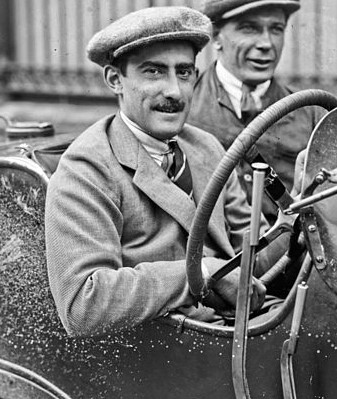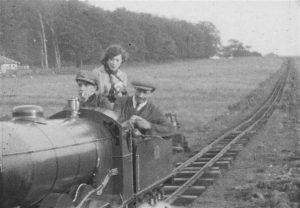 Count Louis Zborowski (1895-1924)
Count Louis Zborowski (1895-1924)
Count Louis Zborowski was a racing driver and automobile engineer, He inherited his title in 1902, aged seven, when his father Eliot died. His father, “Count” William Eliot Morris Zborowski (1858-1903) was also a racing driver, and died in a racing crash, in 1903 at La Turbie Hillclimb in Nice, France.
Eliot Zborowski and his son Count Louis were both wealthy racing drivers with Polish family lineage who played key roles in British motorsport’s earliest days. Eliot Zborowski, born in New Jersey, was an accomplished horseman before the growing tide of interest in automobiles swept him up in 1898. It is said that in 1903 it was Eliot Zborowski who suggested green should become Britain’s national racing colour – in honour of Ireland. The Gordon Bennett Cup, the precursor to Grand Prix motor races, was run in Kildare because of strict speed restrictions on British roads, and Eliot Zborowski is alleged to have made the gesture in tribute to the host country, which led to the foundation of what would become the world-famous British Racing Green. He was killed in the same year at La Turbie hillclimb in France driving a Mercedes 60 factory racer.
After the death of his father in 1903, in 1910 his mother bought the Higham Park estate at Bridge near Canterbury in Kent. Paying £17,500 to the executors of the estate of London banker William Gay, the sale included a farm, 225 acres (91 ha) and twelve houses. Mrs Zborowski immediately commissioned a £50,000 refurbishment of the house from the architect Joseph Sawyer.
His mother was a wealthy American heiress, born Margaret Laura Astor Carey (1853-1911), a granddaughter of William Backhouse Astor, Sr. of the prominent Astor family. On her death in 1911, 16 year old Louis instantly became the fourth richest under-21-year-old in the world, with cash of £11 million and real estate in the United States, including 7 acres (2.8 ha) of Manhattan and several blocks on Fifth Avenue, New York.
Count Louis Zborowski also caught the racing bug from his father, Zborowski participated in prestigious events, including the French Grand Prix and the Indianapolis 500 racing a Bugatti. He later joined forces with Aston Martin for racing endeavors, contributing his innovative approach to automotive design and speed. At the 1924 Italian Grand Prix at Monza racing for Mercedes, on lap 43 Zbowski pitted to change the rear wheels and spark plugs. After restarting, on lap 44 his car skidded in the dangerous North Turn and hit the outer edge of the track from where the car shot across to the inside, hitting a post which bent the front axle and right front wheel, ejecting the riding mechanic who suffered light injuries. The car carried on ending up against a nearby tree. Count Zborowski was pulled out of the car, totally disfigured with a bloody face due to a badly broken scull. He died during transport to the hospital.
His legacy had already been assured by the creation of four cars known as ‘Chitty Bang Bang’, which he raced at Brooklands. Zborowski and his aero-engined monsters inspired James Bond author Ian Fleming to write ‘Chitty Chitty Bang Bang’, his children’s book that was also turned into a popular movie starring Dick Van Dyke.
Count Louis Zborowski – Life & Legacy
 Zborowski was a railway enthusiast and a 15 in (381 mm) gauge railway circuit, the Higham Railway, was built around his estate in Kent. This line was part of the inspiration behind the joint decision by Zborowski and his racing friend Captain J.E.P. Howey to construct a long-distance passenger-carrying railway line in the same gauge. Many locations were investigated, but this eventually led to the founding of the 14-mile (23 km) long Romney, Hythe and Dymchurch Railway in Kent, which remains a popular tourist attraction and means of local transport. Zborowski ordered a steam locomotive from Bassett-Lowke, which ran on the Higham Railway in 1924. The locomotive was purchased by the Fairbourne Railway in Wales following the Count’s death and named “Count Louis” in his honour. The locomotive remained at the Fairbourne until 1988. Zborowski also ordered the first locomotives for the Romney, Hythe and Dymchurch Railway from Davey Paxman & Co. of Essex. He never saw the Romney, Hythe and Dymchurch Railway in action because of his untimely death but the project was continued by Capt Howey.
Zborowski was a railway enthusiast and a 15 in (381 mm) gauge railway circuit, the Higham Railway, was built around his estate in Kent. This line was part of the inspiration behind the joint decision by Zborowski and his racing friend Captain J.E.P. Howey to construct a long-distance passenger-carrying railway line in the same gauge. Many locations were investigated, but this eventually led to the founding of the 14-mile (23 km) long Romney, Hythe and Dymchurch Railway in Kent, which remains a popular tourist attraction and means of local transport. Zborowski ordered a steam locomotive from Bassett-Lowke, which ran on the Higham Railway in 1924. The locomotive was purchased by the Fairbourne Railway in Wales following the Count’s death and named “Count Louis” in his honour. The locomotive remained at the Fairbourne until 1988. Zborowski also ordered the first locomotives for the Romney, Hythe and Dymchurch Railway from Davey Paxman & Co. of Essex. He never saw the Romney, Hythe and Dymchurch Railway in action because of his untimely death but the project was continued by Capt Howey.
Following his death, villagers in Patrixbourne began to see visions of the a ghostly Chitty Chitty Bang Bang thundering through the lanes. Author Ian Fleming had long been a fan of Count Zborowski, first watching in awe as a boy when he raced at Brooklands. Later when his friend Walter Whigham acquired Higham Park, re-naming it Highland Court, he visited the estate and learned more about the Count’s exploits which inspired him to write the story. The children’s book by Ian Fleming, Chitty Chitty Bang Bang, and the subsequent musical film, were inspired by the romance of Zborowski’s exploits. Fleming had watched Zborowski race at Brooklands as a school boy.


You must be logged in to post a comment.